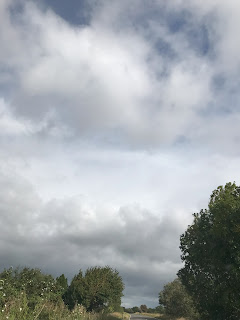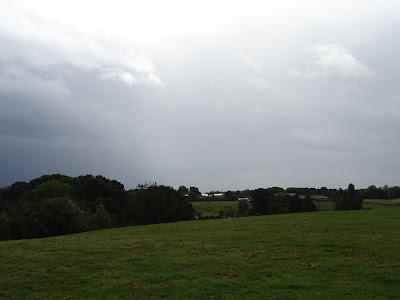Wednesday 18th September 2024
The day before our visit to Fordhall Farm I received several messages full of doom and gloom about the following day's weather forecast. A check of the Met Office website confirmed that the pessimism was well founded with a predicted 80-95% chance of rain throughout the day.
It was only a forecast so I decided not to cancel but wait and see what the morning brought before making a final decision.
The early morning of the outing was greeted by cloudless blue skies!!
However, the weather forecast was unmoved, still predicting 80-95% chance of rain.
The sun was beating down ... how could I cancel the trip?
As we set off on our journey to the site there was still not a cloud in sight and the sky was a radiant blue.
After a few miles we saw our first clouds.
As we approached Hodnet the rain clouds were gathering.
As we travelled along the Hodnet by-pass, it started to rain.
And as we parked the car at Fordhall Farm it was raining heavily.
Should we get out ... or stay in the car?
After a few minutes thought we got out ...
And made a dash to the café.
As we sipped our teas and coffees, resisting the temptation of the fried bacon smells emanating from the kitchen, we discussed, amongst other things, what we should do.
Weather apps on mobile phones were consulted.
A pause in the rain was approaching.
How long was the pause?
About 10 minutes.
But there were more pauses expected later.
Oh, and by the way, it's sunny in Horsehay!
The rain stopped. We had finished our refreshments. We ventured out.
As more rain was imminent we did not venture far from the car park and café by moving towards the community garden area.
We dallied on the way passing a pig (Gloucester Old Spot?) enjoying some quiet downtime ...
Before returning to work feeding the hungry hoards.
An early suction sample from the vegetation at the side of the path to the garden revealed several Scarlet tiger moth larvae.
Moving into the garden we found the small ladybird Rhyzobius litura.
 |
| Photograph: David Williams |
Our 10 minute pause was over. To be fair it was more like 30 minutes before it started to rain again. Fortunately, in the garden, there was a polytunnel and a covered picnic area that provided shelter.
The rain stopped after 15 minutes or so and we resumed our activities.
The garden contained 4 compost bins. One of these was formed from a mixture of food waste and sawdust. This was a magnet for our Demapterist, who, with little effort, uncovered a 4th instar nymph of a Lesser earwig, Labia minor.
 |
| Photograph: David Williams |
The draw of the compost bin was far too great to overcome and he returned later in the day and found several adults. Here is a female.
%20DW%202024-09-11%20(3).jpg) |
| Photograph: David Williams |
And to give you and indication of their size here is another adult female alongside his thumb.
%20DW%202024-09-11%20(1).jpg) |
| Photograph: David Williams |
Looking over towards the horizon the dark clouds seemed to be gathering for a further assault.
The rain did not arrive ...
The sun came out!
We took advantage of this interlude and had lunch.
Lunch over we moved down towards the River Tern, On the way we spotted a log with finger-like structures appearing out of it.
These are caused by the fungus known as Dead moll's fingers.
We lingered for quite a while by the river inspecting the trees and wet grassland.
There were a number of Alders in this area and we spotted quite a few of the large, colourful mirid bug Pantilius tunicatus. There were also a few nymphs of this species; here is one.
Once again threatening clouds gathered.
This time they meant it.
It rained.
Shelter was sought under one of the large Alders.
The rain stopped, eventually, but we decided to call it a day. As we walked back through the garden area the sun came out and it was impossible to resist one last search.
The species collected from this area included several individuals of a tiny mirid bug, Chlamydatus evanescens. This was only the 3rd time this species had been recorded in the county. They are normally a coastal species but they have moved inland, possibly aided by imported Sedums. A little more can be found out about the species on the British Bugs website: Chlamydatus evanescens.
To finish the day we returned to the café for drinks and cakes provided. very kindly, by our hosts.
My thanks to Fordhall Farm for giving us permission to do what we enjoy doing and for their excellent hospitality, to the weather for giving us enough breaks in the rain to allow us to spend a reasonable amount of time exploring the farm, and to the photographers for sharing their images.

















No comments:
Post a Comment
Please feel free to comment on this post...